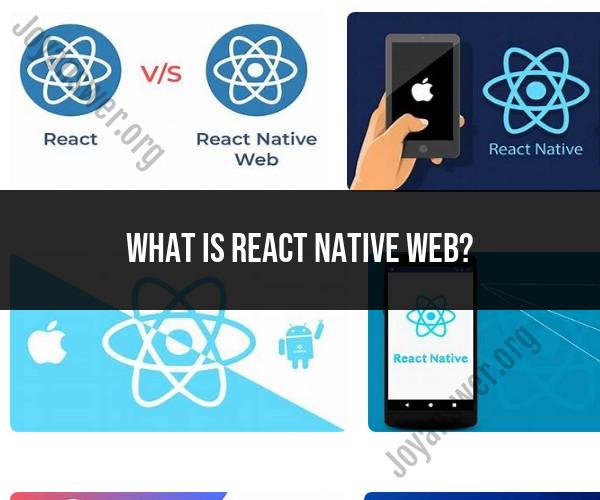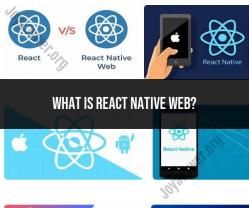What is React Native web?
React Native Web is an open-source library that allows developers to build web applications using the same codebase that's used for React Native mobile applications. It enables cross-platform development, which means you can create web and mobile applications with a single set of JavaScript and React components. React Native Web aims to make it easier for developers to maintain and share code between web and mobile platforms.
Here are some key points about React Native Web:
Code Reusability: With React Native Web, you can reuse a significant portion of your codebase between your web and mobile applications. This helps save development time and effort, as changes or updates only need to be made in one place.
React and React Native Compatibility: React Native Web builds on React Native, utilizing its components and the React library. If you're already familiar with React Native, transitioning to React Native Web is relatively straightforward.
Web Platform Support: React Native Web is designed to work with web technologies. It allows you to create web applications that can run in modern web browsers.
Customization: While much of the code can be shared between web and mobile, React Native Web allows for platform-specific adjustments, allowing you to tailor your application's appearance and functionality for each platform.
Community Support: React Native Web has an active and growing community of developers who contribute to its development and provide support through forums, documentation, and tutorials.
Ecosystem Integration: You can integrate various libraries, packages, and tools commonly used in the React and React Native ecosystems into your React Native Web project.
Responsive Design: React Native Web allows you to create responsive web applications that adapt to different screen sizes and orientations.
Web-Specific Components: While many components are shared between mobile and web, React Native Web includes a set of components specific to web development, allowing you to take advantage of web features and functionalities.
Server-Side Rendering (SSR): React Native Web supports server-side rendering, which can enhance initial page load times and improve search engine optimization (SEO) for web applications.
Performance: While React Native Web provides a way to share code, it's important to optimize your application for each platform. Mobile and web performance considerations can be different.
React Native Web is a valuable tool for businesses and developers looking to create cross-platform applications that share a common codebase while still delivering a tailored user experience on both web and mobile devices. It's particularly useful for projects where consistency in functionality and design is essential across multiple platforms.
Exploring React Native Web: A Multi-Platform Framework
React Native Web is a multi-platform framework for building web applications using React. It allows developers to write a single codebase for both web and mobile applications, which can save time and money.
React Native Web is based on the React Native framework, which is a popular framework for building mobile applications. React Native Web uses the same React components and APIs as React Native, but it compiles them to JavaScript that can be run in a web browser.
Key Features and Advantages of React Native Web
Some of the key features and advantages of React Native Web include:
- Cross-platform development: React Native Web allows developers to write a single codebase for both web and mobile applications. This can save time and money, as developers do not have to write separate codebases for each platform.
- Performance: React Native Web applications are typically very performant, as they are rendered using native web technologies.
- Developer experience: React Native Web uses the same React components and APIs as React Native, which makes it easy for developers to learn and use.
- Community support: React Native Web has a large and active community of developers, which means that there are many resources and support available.
Developing Cross-Platform Applications with React Native Web
To develop a cross-platform application with React Native Web, you can follow these steps:
- Create a new React Native project using the
npx create-react-native-app my-appcommand. - Install the
react-native-webpackage using thenpm install react-native-webcommand. - Update the
index.jsfile to import thereact-native-webpackage and render your React Native application. - Start the development server using the
npm startcommand. - Open the application in a web browser to view it.
Examples of React Native Web in Action
Some popular examples of React Native Web applications include:
- Facebook: Facebook uses React Native Web to render its website.
- Airbnb: Airbnb uses React Native Web to render its website and its mobile application.
- Netflix: Netflix uses React Native Web to render its website.
Tips for Choosing the Right Framework for Your Project
When choosing the right framework for your project, it is important to consider the following factors:
- Your team's skills and experience: If your team is already familiar with React Native, then React Native Web may be a good choice for your project.
- The target platforms: If you need to develop an application for both web and mobile, then React Native Web is a good choice.
- Your budget: React Native Web can save you time and money by allowing you to write a single codebase for both web and mobile applications.
If you are still unsure which framework to choose, you can consult with a development expert. They can help you to assess your needs and choose the right framework for your project.






